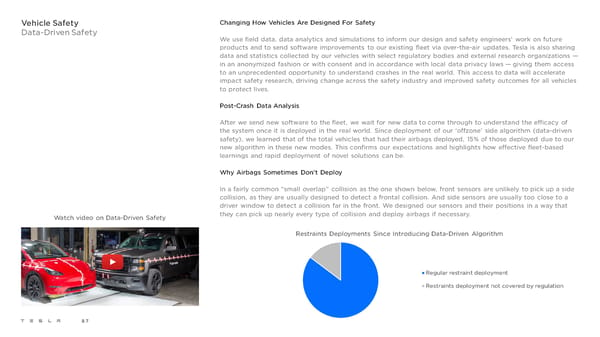Vehicle Safety Changing How Vehicles Are Designed For Safety Data-Driven Safety We use field data, data analytics and simulations to inform our design and safety engineers’ work on future products and to send software improvements to our existing fleet via over-the-air updates. Tesla is also sharing data and statistics collected by our vehicles with select regulatory bodies and external research organizations — in an anonymized fashion or with consent and in accordance with local data privacy laws —giving them access to an unprecedented opportunity to understand crashes in the real world. This access to data will accelerate impact safety research, driving change across the safety industry and improved safety outcomes for all vehicles to protect lives. Post-Crash Data Analysis After we send new software to the fleet, we wait for new data to come through to understand the efficacy of the system once it is deployed in the real world. Since deployment of our ‘offzone’ side algorithm (data-driven safety), we learned that of the total vehicles that had their airbags deployed, 15% of those deployed due to our new algorithm in these new modes. This confirms our expectations and highlights how effective fleet-based learnings and rapid deployment of novel solutions can be. Why Airbags Sometimes Don’t Deploy In a fairly common “small overlap” collision as the one shown below, front sensors are unlikely to pick up a side collision, as they are usually designed to detect a frontal collision. And side sensors are usually too close to a driver window to detect a collision far in the front. We designed our sensors and their positions in a way that Watch video on Data-Driven Safety they can pick up nearly every type of collision and deploy airbags if necessary. Restraints Deployments Since Introducing Data-Driven Algorithm Regular restraint deployment Restraints deployment not covered by regulation 87
 Tesla 2021 Impact Report Page 86 Page 88
Tesla 2021 Impact Report Page 86 Page 88